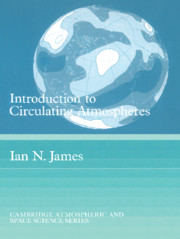Book contents
- Frontmatter
- Contents
- Preface
- Notation
- l The governing physical laws
- 2 Observing and modelling global circulations
- 3 The atmospheric heat engine
- 4 The zonal mean meridional circulation
- 5 Transient disturbances in the midlatitudes
- 6 Wave propagation and steady eddies
- 7 Three-dimensional aspects of the global circulation
- 8 Low frequency variability of the circulation
- 9 The stratosphere
- 10 Planetary atmospheres and other fluid systems
- Appendix: Solutions to Problems
- Bibliography
- References
- Index
6 - Wave propagation and steady eddies
Published online by Cambridge University Press: 14 January 2010
- Frontmatter
- Contents
- Preface
- Notation
- l The governing physical laws
- 2 Observing and modelling global circulations
- 3 The atmospheric heat engine
- 4 The zonal mean meridional circulation
- 5 Transient disturbances in the midlatitudes
- 6 Wave propagation and steady eddies
- 7 Three-dimensional aspects of the global circulation
- 8 Low frequency variability of the circulation
- 9 The stratosphere
- 10 Planetary atmospheres and other fluid systems
- Appendix: Solutions to Problems
- Bibliography
- References
- Index
Summary
Observations of steady eddies
Despite the eddy–zonal flow partitioning which we have employed in preceding chapters, the seasonal mean flow is very far from being zonally symmetric. Such departures from symmetry are important in accounting for regional variations of climate. They also modify the global patterns of heat and momentum transport, especially in the northern hemisphere winter. In this chapter, we will discuss some observations of the steady wave pattern, and show how rather simple theories based on linear wave propagation can account for some of the gross features of these observations.
The steady waves are most pronounced in the northern hemisphere winter, and have their largest amplitudes in the upper troposphere. In some circumstances, they also become very important at high levels in the winter stratosphere, a point that we will return to in Chapter 9. Figure 6.1 shows the winter mean geopotential height field at 25 kPa in both hemispheres. The characteristic features of the northern hemisphere picture are the pronounced troughs over Canada and Japan, with ridges over the eastern side of the two ocean basins. One's subjective impression is of a predominantly zonal wavenumber 2 pattern. This general pattern is very persistent and can be seen in individual seasons with only relatively small variations. The corresponding picture for the southern hemisphere looks, at first sight, much more axisymmetric.
- Type
- Chapter
- Information
- Introduction to Circulating Atmospheres , pp. 164 - 207Publisher: Cambridge University PressPrint publication year: 1994



